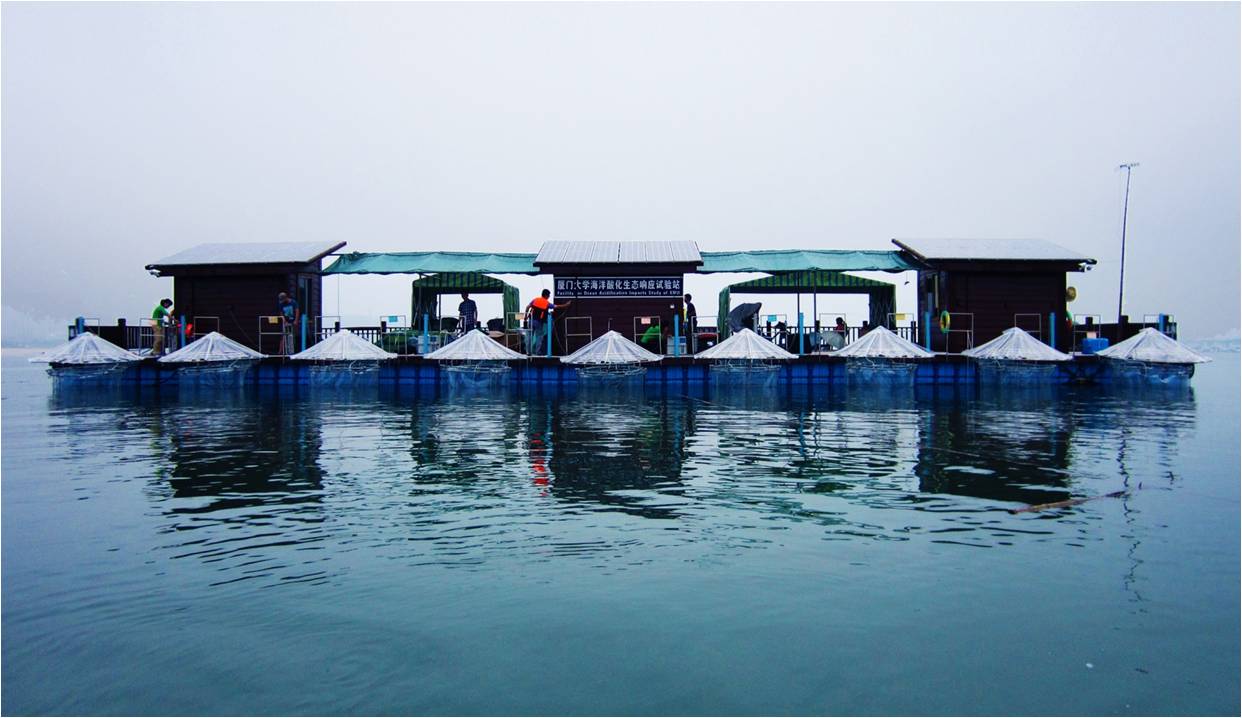人类活动排放的CO2持续增加,导致海洋的pH下降,引起海洋酸化,海洋可能正以迄今地球历史3亿年来最快速度酸化。海洋酸化对生物、食物链、生物多样性、生态系统的影响,引起科学界及社会各界的广泛关注,海洋生物及生态系统对海洋酸化的响应将面临种种挑战。
为了探讨海洋酸化对海洋生物及生态系统的影响及其机制,实验室在五缘湾建成“海洋酸化影响研究中水量试验平台” (FOANIC-XMU) (24°31′48″N, 118°10′47″E)。该平台尺寸为35米×7米,有每个容量为4吨的培养水体框架,全球首个使用全太阳能驱动供电,供仪器测定等使用,建有3个面积为9m2的实验室,是亚洲最大的围隔试验平台。平台上的活动,可实时监控并录像。不同CO2浓度由CO2加富器(武汉瑞华)提供。酸化状态通过CO2加富逐渐诱导。厦门大学的研究团队及其合作者,将研究浮游植物种间竞争、初级生产力、食物链过程等与酸化的关系。平台自2013年初建成以来,已在5-7月完成一个海洋酸化效应实验,探讨酸化及海水碳酸盐化学变化对浮游植物种群竞争及生理过程的影响,还开展数次潮间带和其他实验。2014年初,将利用该平台,探讨贝类发育、贝类养殖生态系统过程与酸化的关系。

The pH of the world’s oceans is falling as a result of anthropogenic CO2 emissions to the atmosphere. Such an ocean acidification phenomenon is progressive at an unprecedented rate in Earth’s history. The rate of change has been estimated to be faster than at any time in the last 300 million years. The acidity of surface oceans is predicted to increase by 150% by the end of this century. The far-reaching effects of ocean acidification on food webs, biodiversity, fisheries and aquaculture and then societies are of general concerns to scientific communities and the general public. Predicting how organisms and ecosystems will change in response to ocean acidification remains challenging.
To explore mechanistic influences of ocean acidification, Mesocosm Facility for Ocean Acidification Impact Study of State Key Laboratory of Marine Environmental Science (MEL, Xiamen University) (FOANIC-XMU)has been successfully set up in Wuyuan Bay (N24°31′48″, E118°10′47″). The floating platform, with the dimension of 35×7 m, has three independent rooms (9 m2 each ) and nine 4-m3 mesocosms, and is fully solar-powered, for all instruments on board. Activities on the platform are monitored and recorded continuously. Different levels of CO2 in the mesocosms can be achieved by the commercially available CO2-enriching device (CO2 enrichlor, Ruihua, Wuhan, China). Ocean acidification (OA) conditions can be induced gradually with aeration from the CO2 enrichors. Effects of OA on phytoplankton species competition, primary productivity, food chain effect and microbial processes will be examined by MEL group and their collaborating scientists to look into the OA impacts on species, community, and ecosystem levels.
The first experiment has been carried out during May - July, 2013 to understand the competition of different phytoplankton groups, mainly diatoms and coccolithorphores under ambient and elevated CO2 concentrations, which are achieved with a CO2-enriching device. Another mesocosm experiment is planned in 2014 to investigate the effects of OA on shellfish development and shellfish farming ecosystem processes.